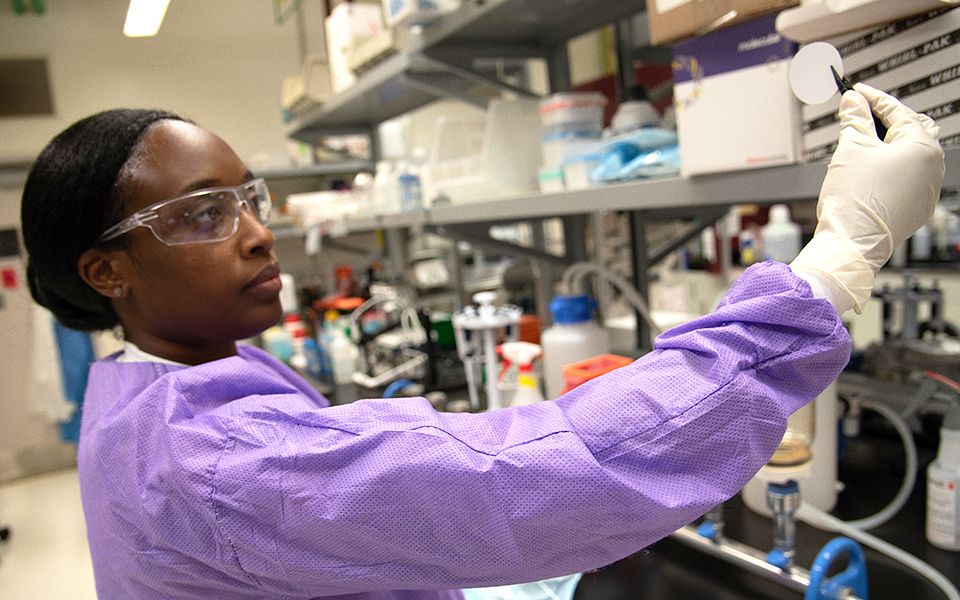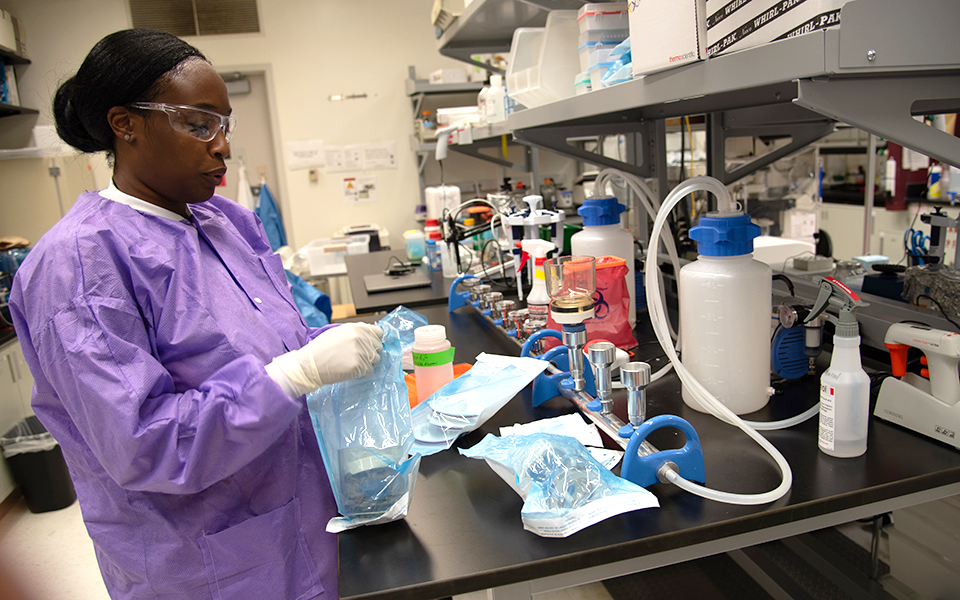Taking Measure
Just a Standard Blog

I grew up in a small town with limited medical resources, and I have a brother who is immunocompromised. My brother’s condition impacts his daily life, which has been stressful for my family and me.
I was determined to have a graduate career in science. Because my biggest motivation is family, I wanted to work in a field that was directly related to helping people like my brother who have immunocompromising and other health conditions.
After I earned my Ph.D., I came to NIST and started studying microbial water quality, specifically as it relates to residential plumbing.
You may wonder what plumbing has to do with health and immunocompromising conditions.
Pathogens can get into our water through plumbing. They are known as opportunistic premise plumbing pathogens. When a plumbing system condition allows bacteria to grow to a dangerously high level, it can lead to pneumonia and other health conditions. This is especially dangerous for people with compromised immune systems, such as those with diabetes and cancer, as well as people who smoke.
I studied water temperature and water use in homes in a laboratory house on NIST’s campus in Gaithersburg, Maryland. The purpose of the study was to make a connection between these factors and dangerous bacteria. Our study suggested that higher water usage overall and using water at a higher temperature led to fewer pathogens in the plumbing.
Our results fit with the existing scientific understanding that unused water in buildings may lead to a buildup of plumbing pathogens, although this needs to be studied further in more types of residential buildings.
Setting the Standard for Wastewater Surveillance
My area of expertise is also relevant to something that has been in the news since the onset of COVID-19 — wastewater surveillance. Wastewater surveillance is simply testing an area’s wastewater to estimate the levels of infection in a community. You may have just heard about it during COVID-19, but it’s been used for decades to track polio and other viruses.
It’s not practical to test every person in a city or state for a virus. That’s why wastewater testing is useful. It can give scientists and local officials an idea of what viruses are circulating in the community and allow leaders to plan accordingly.
One of the challenges with wastewater surveillance is that communities and states take their own approaches. We need to be able to compare data across jurisdictions to better understand infection levels.
We can’t compare data among different states if each state tests differently. Even within a state, testing approaches and methodologies often vary. We also want to make sure scientists can document their results. Other scientists should be able to follow the documentation and reproduce the results. To do this, we need consistency in approaches across labs.
I’m co-leading the development of a best practice document that will offer optional guidance to health departments and other laboratories on the many different approaches used for concentrating wastewater samples for testing.
For example, some laboratories use a process that concentrates wastewater samples using a pore-filled membrane so the microorganisms can be analyzed.
Our document will offer best practices on how to use this method successfully. Even seemingly mundane suggestions, such as remembering to change your gloves between each sample, so there’s no carryover contamination, make a difference in data quality.
If states and communities adopt it, we’ll have a better understanding of the national picture of viral conditions, such as polio and flu, because we’ll be able to compare data across the country.

One of the most important ways to ensure high-quality testing of wastewater is to validate our testing methodologies. When you take a sample of wastewater, you don’t yet know how much virus is in that sample. How do you know if your test results will give you the best possible information?
Here’s one approach. Scientists take a substance that is not found in wastewater naturally — such as a type of cattle vaccine — and inject a known amount into the wastewater sample they are testing in the lab. They then run their tests and track how much vaccine is lost over the course of the tests. The vaccine injected in the water serves as the stand-in for the pathogen that will later be tested using the same methodology.
The goal is to lose as little of the vaccine as possible because you want to ensure that your method is processing the sample properly and maintaining the amount of virus in the sample for later measurements. Scientists can then repeat this same process for a virus in a sample of wastewater, and ideally, they will get similar amounts of the virus in the test.
By testing our practices this way, we can validate our methodologies to ensure we have the best possible data.
The Evolving Field of Wastewater Research
This field will continue to develop in the coming years. I’m excited to keep researching all things related to health and water. One of the key factors for advancing this science is data, and I’m hoping the standards we are creating here will lead to better data for researchers.
I hope in the future not only that we will have a best practice standard for testing wastewater, but also that we can tailor testing to specific viruses we’re searching for. We may find better ways to test for certain viruses than others.
It’s very gratifying to be able to help people stay healthy — whether it’s monitoring the water we drink or keeping an eye on bacteria in our wastewater.
This work is very meaningful, and I’m aware of the impact I’m having on communities across the country, especially for people with immunocompromising conditions.
About the author
Related Posts
Comments
I'm one of your immunocompromised persons and I have been dealing with sarcoidosis for the past 45 years. Along the way, I have added CLL and T2 diabetes. I live in a mobile home in the pleasant Texas.
I have had times when my white count was closer to zero than I would have desired and spent 3 mos. with a platelet count right around 10 and they wouldn't allow me out of bed, much less out of the hospital. They rebuilt my immune with concentrated factors from hundreds of people.
So far, by beconming something of a hermit and takiing every vaccine available, I have survived with two strong bouts of shingles, but nothing else except 6 rounds of CLL treatment.
I'm hoping that folks like you will be able to decipher the immune system sufficiently to allow the immune system to work against all diseases and edit the genome to fix all these genetic based problems.
Keep working and pass your devotion to those efforts on to the generations that it will take to àccomplish these goals.
In my rural community, a mid-century home, vacant for several years previous to my purchase has plumbing leak for several years resulting in black mold coming between the floor boards. A plumbing company "repaired" a broken cast iron plumbing joint by simply replacing it but failed to ensure that this material had not been breached along plumbing line. How do I get my home certified or evaluated to be clear of pulmonary corrosive/debilitating chemical elements. I do not feel the problem is "repaired" nor safe.
Thank you for your comment. We'd encourage you to contact your local health department and/or a plumber to address this issue.
Plumbing systems can sometimes harbor harmful pathogens if not properly maintained, posing health risks to occupants. Regular inspections and maintenance help prevent the buildup of bacteria and mold in pipes. By investing in professional plumbing estimating services, property owners can plan upgrades or replacements efficiently to ensure a safer water system. Clean, well-designed plumbing not only protects your health but also enhances your property’s overall value.
Excellent research on opportunistic premise plumbing pathogens (OPPPs) and
their impact on immunocompromised populations. Your work on water temperature
and usage patterns is critical because many homeowners don't realize how
stagnant water in pipes creates the perfect breeding environment for these
bacteria.
The connection between water usage and pathogen reduction makes practical
sense consistent water flow prevents biofilm formation. In residential service
calls, I've noticed that vacation homes or seasonal properties often have
significantly worse plumbing quality issues than regularly occupied homes,
which aligns with your research findings.
Your point about higher water temperature reducing pathogens is especially
important for homes with vulnerable occupants. The balance between energy
efficiency and health protection is a real challenge homeowners face.
The wastewater surveillance standardization work you're leading is absolutely
crucial. Consistency in testing methodologies across states would dramatically
improve public health decision-making. Your mention of even small details like
changing gloves between samples shows how attention to detail in scientific
protocol directly impacts data reliability.
The validation methodology using cattle vaccine as a proxy is brilliant. It's
a practical way to ensure testing methods capture actual pathogen levels
accurately.
This research directly impacts vulnerable populations who depend on safe
residential plumbing systems. Keep pushing this critical work forward
standardized testing will save lives.






Very informative article. If hot water in tanks is not hot enough to kill pathogens I'll effects can reverberate within a home or office.